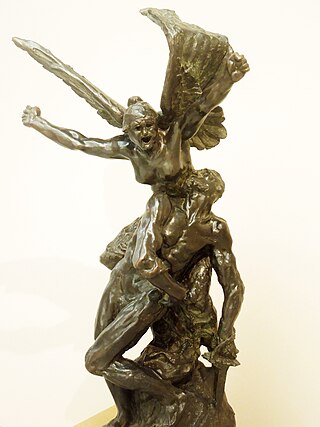
François Auguste René Rodin was a French sculptor, generally considered the founder of modern sculpture. He was schooled traditionally and took a craftsman-like approach to his work. Rodin possessed a unique ability to model a complex, turbulent, and deeply pocketed surface in clay. He is known for such sculptures as The Thinker, Monument to Balzac, The Kiss, The Burghers of Calais, and The Gates of Hell.

The Burghers of Calais is a sculpture by Auguste Rodin in twelve original castings and numerous copies. It commemorates an event during the Hundred Years' War, when Calais, a French port on the English Channel, surrendered to the English after an eleven-month siege. The city commissioned Rodin to create the sculpture in 1884 and the work was completed in 1889.

The Kiss is an 1882 marble sculpture by the French sculptor Auguste Rodin.

The Age of Bronze is a bronze statue by the French sculptor Auguste Rodin (1840–1917). The figure is of a life-size nude male, 72 in. (182.9 cm) high. Rodin continued to produce casts of the statue for several decades after it was modelled in 1876.
Plateau was an art gallery in South Korea on Taepyeongno street in Jongno-gu, a central district of Seoul. The gallery contained sculptures of Auguste Rodin (1840–1917). It opened on the first floor of Samsung Life Insurance building on May 14, 1999, as 'Rodin Gallery'. In May 2011 the gallery was renamed 'Plateau' in order to better express its 'commitment to embracing the Korean and international contemporary Art Scene'. It closed in August 2016.

Crouching Woman is a bronze sculpture by Auguste Rodin.

Saint John the Baptist (preaching) is a bronze sculpture, by Auguste Rodin.

The Spirit of Eternal Repose is a 1898–1899 sculpture of a sprite by French artist Auguste Rodin.

Cybele is a sculpture by French artist Auguste Rodin. It is one of the first of Rodin's partial figures known as "fragments" to be displayed as sculpture in its own right, rather than an incomplete study.

Brother and Sister is an 1890 bronze sculpture by Auguste Rodin.

The Prodigal Son is a sculpture by Auguste Rodin.

Fugitive Love is a sculpture by Auguste Rodin made between 1886 and 1887, both sculpted in marble and cast in bronze. It represents a man and a woman embracing each other on top of a rock. More specifically, the author was inspired by the story of Francesca da Rimini's love affair with Paolo Malatesta, an allusion to Dante Alighieri's depiction of lust on the second circle of Hell in his Inferno.

Pierre de Wissant is a bronze sculpture by French artist Auguste Rodin, part of his sculptural group The Burghers of Calais. This sculpture represents one of the six burghers who, according to Jean Froissart surrendered themselves in 1347, at the beginning of the Hundred Years' War (1337–1453), in order to save the inhabitants of the French city of Calais from the English laying siege to the city.

La Defense, also known as The Call to Arms, is a sculpture by Auguste Rodin.

Eve is a nude sculpture by the French artist Auguste Rodin. It shows Eve despairing after the Fall.

Glaucus is a sculpture by the French artist Auguste Rodin, first conceived in 1886 as a representation of the mythological figure Glaucus, son of Poseidon. Originally made in plaster, bronze casts of it are now in the Brooklyn Museum and the Museo Soumaya.

Despair or Despair at the Gate is a sculpture by Auguste Rodin that he conceived and developed from the early 1880s to c. 1890 as part of his The Gates of Hell project. The figure belongs to a company of damned souls found in the nine circles of Hell described by Dante in The Divine Comedy. Other title variations are Shade Holding her Foot, Woman Holding Her Foot, and Desperation. There are numerous versions of this work executed as both plaster and bronze casts and carved marble and limestone.

Damned Women is a sculpture created by Auguste Rodin between 1885 and 1890 as part of his The Gates of Hell project—it appears on the upper right as the counterpart to The Fallen Caryatid.

Illusions Received by the Earth or The Fallen Angel is a sculpture by Auguste Rodin, conceived before 1900 and cast before 1952 by the Rudier Foundry.


















